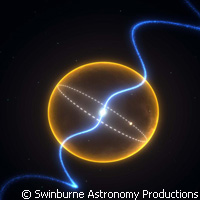Sparkling astronomical discovery: diamond planet in Milky Way
An international team of astronomers has discovered the existence of a planet made out of diamond in the Milky Way. The extraordinary find is thought to be have once been a massive star before turning into the much smaller diamond planet. Writing in the journal Science, the astronomers, from Australia, Germany, Italy, the United Kingdom and the United States, explain that they first detected an unusual star called a pulsar using the Commonwealth Scientific and Industrial Research Organisation (CSIRO) Parkes radio telescope in Australia. They then followed up this sighting using the Lovell radio telescope in the United Kingdom and one of the Keck telescopes in Hawaii. Pulsars are small spinning stars about 20 km in diameter (the size of a small city) that emit a beam of radio waves. As the star spins and the radio beam sweeps repeatedly over Earth, radio telescopes detect a regular pattern of radio pulses. When the team discovered this new pulsar star, numbered PSR J1719-1438, they noticed that the arrival times of the pulses were systematically modulated. They deduced that this could only be down to one thing - the gravitational pull of a small companion planet, orbiting the pulsar in a binary system. The pulsar and its planet are part of the Milky Way's plane of stars; they are located 4,000 light years away from Earth The modulations in the radio pulses tell astronomers several things about the planet. Firstly, it takes just 2 hours and 10 minutes for it to orbit the pulsar; the distance between the two objects is 600,000 km, a little less than the radius of our Sun. Secondly, the planet is so close to the pulsar that if it were any bigger it would be torn apart by the pulsar's gravity. The scientists were also able to tell that, despite its small size - less than 60,000 km, the planet has slightly more mass than Jupiter. Project leader Professor Matthew Bailes from Swinburne University of Technology in Melbourne, Australia describes this feature as providing us with 'a clue to its origin'. The team thinks that the 'diamond planet' is all that remains of a once massive star, most of whose matter was siphoned off towards the pulsar. Pulsar J1719-1438 is a very fast-spinning pulsar: otherwise known as a millisecond pulsar, it rotates more than 10,000 times every minute, and despite being only 20 km in diameter, it has a mass about 1.4 times that of our Sun. About 70% of millisecond pulsars have companions of some kind. Astronomers think it is the companion that, in its star form, transforms an old, dead pulsar into a millisecond pulsar by transferring matter and spinning it up to a very high speed. The result is a fast-spinning millisecond pulsar with a shrunken companion - most often a so-called 'white dwarf'. 'We know of a few other systems, called ultra-compact low-mass X-ray binaries, that are likely to be evolving according to this scenario and may likely represent the progenitors of a pulsar like J1719-1438,' said astronomer Dr Andrea Possenti, Director of the INAF-Osservatorio Astronomico di Cagliari in Italy. However, pulsar J1719-1438 and its companion are so close together that the companion can only be a very stripped-down white dwarf, one that has lost its outer layers and over 99.9% of its original mass. 'This remnant is likely to be largely carbon and oxygen, because a star made of lighter elements like hydrogen and helium would be too big to fit the measured orbiting times,' said CSIRO's Dr Michael Keith, another researcher on the project. The density means that this material is certain to be crystalline, i.e. a large part of the star may be similar to a diamond. The team found pulsar J1719-1438 among almost 200,000 gigabytes of data, by using special codes on supercomputers at Swinburne University of Technology, the University of Manchester in the United Kingdom, and the INAF-Osservatorio Astronomico di Cagliari. The diamond discovery was made during a special search for pulsars that also involved using the 100-metre Effelsberg radio telescope at the Max Planck Institute for Radio Astronomy (MPIfR) in Germany. And although a diamond planet would surely fetch a fair penny here on Earth, in Space its worth is more scientific than monetary, measured in the bounds of enthusiasm displayed by astronomers upon their discovery, as demonstrated by Professor Michael Kramer, director of the MPIfR: 'This is the largest and most sensitive survey of this type ever conducted. We expected to find exciting things, and it is great to see it happening. There is more to come!'For more information, please visit:Swinburne University of Technology:http://www.swinburne.edu.au/
Countries
Australia, Germany, Italy, United Kingdom, United States



